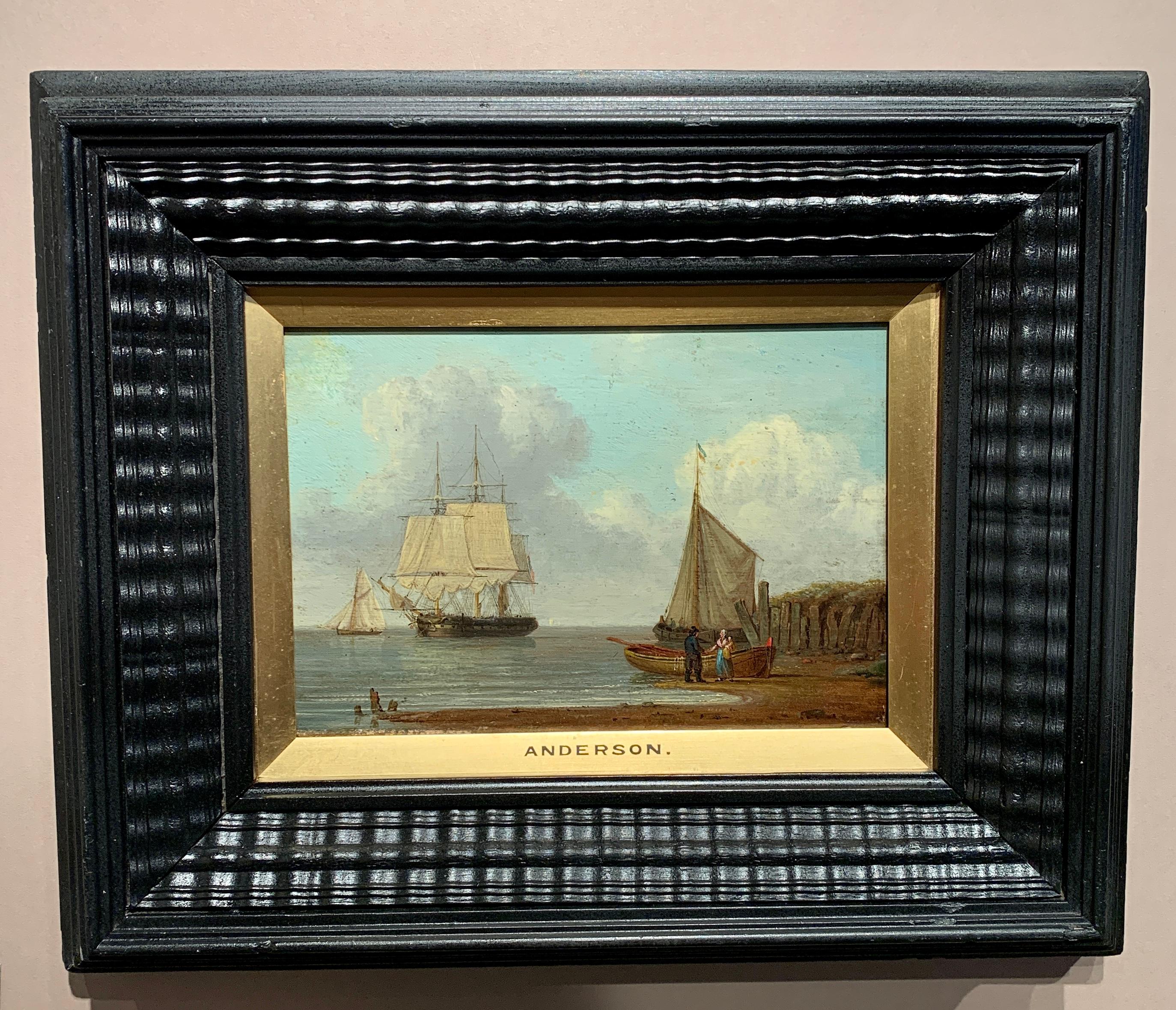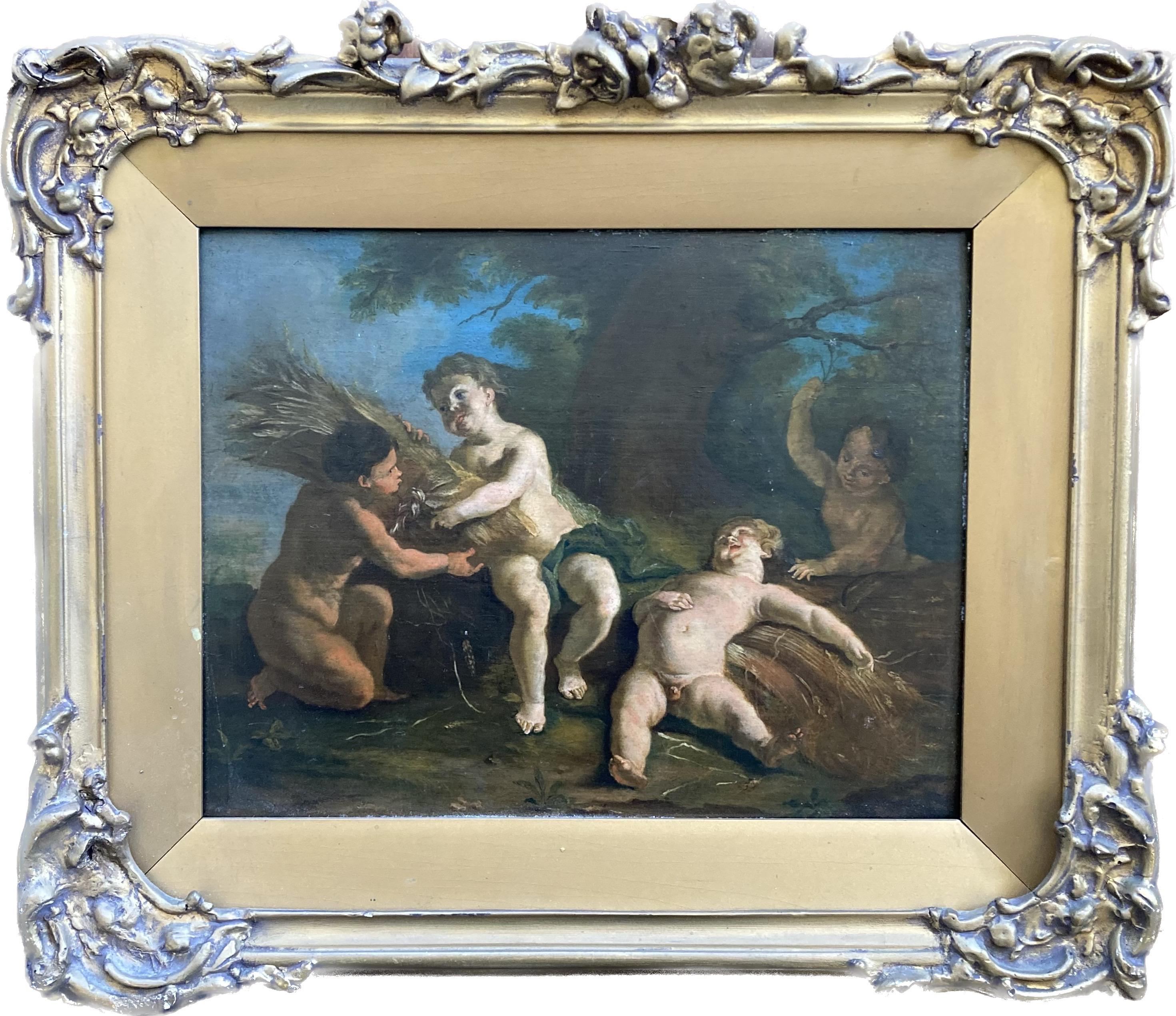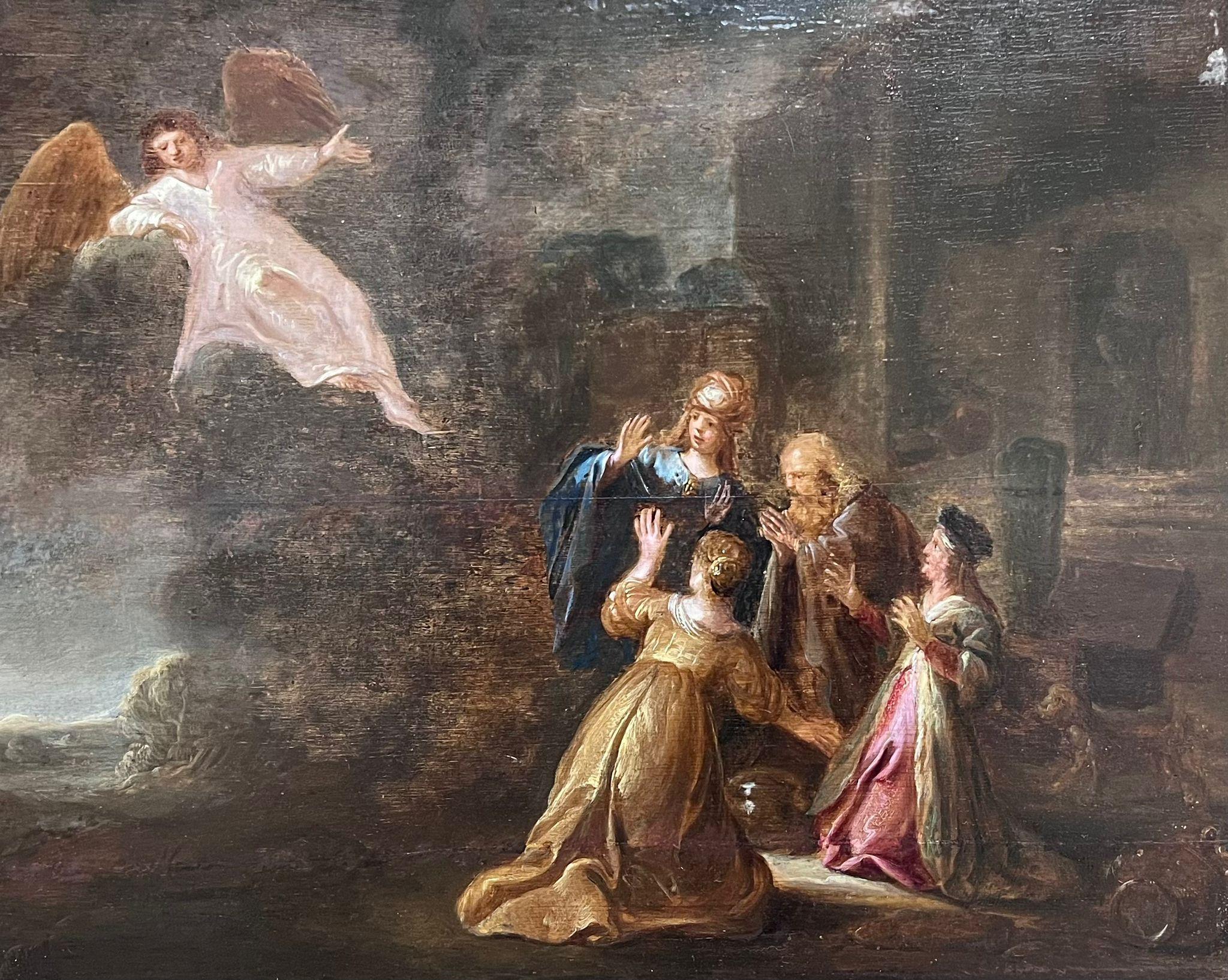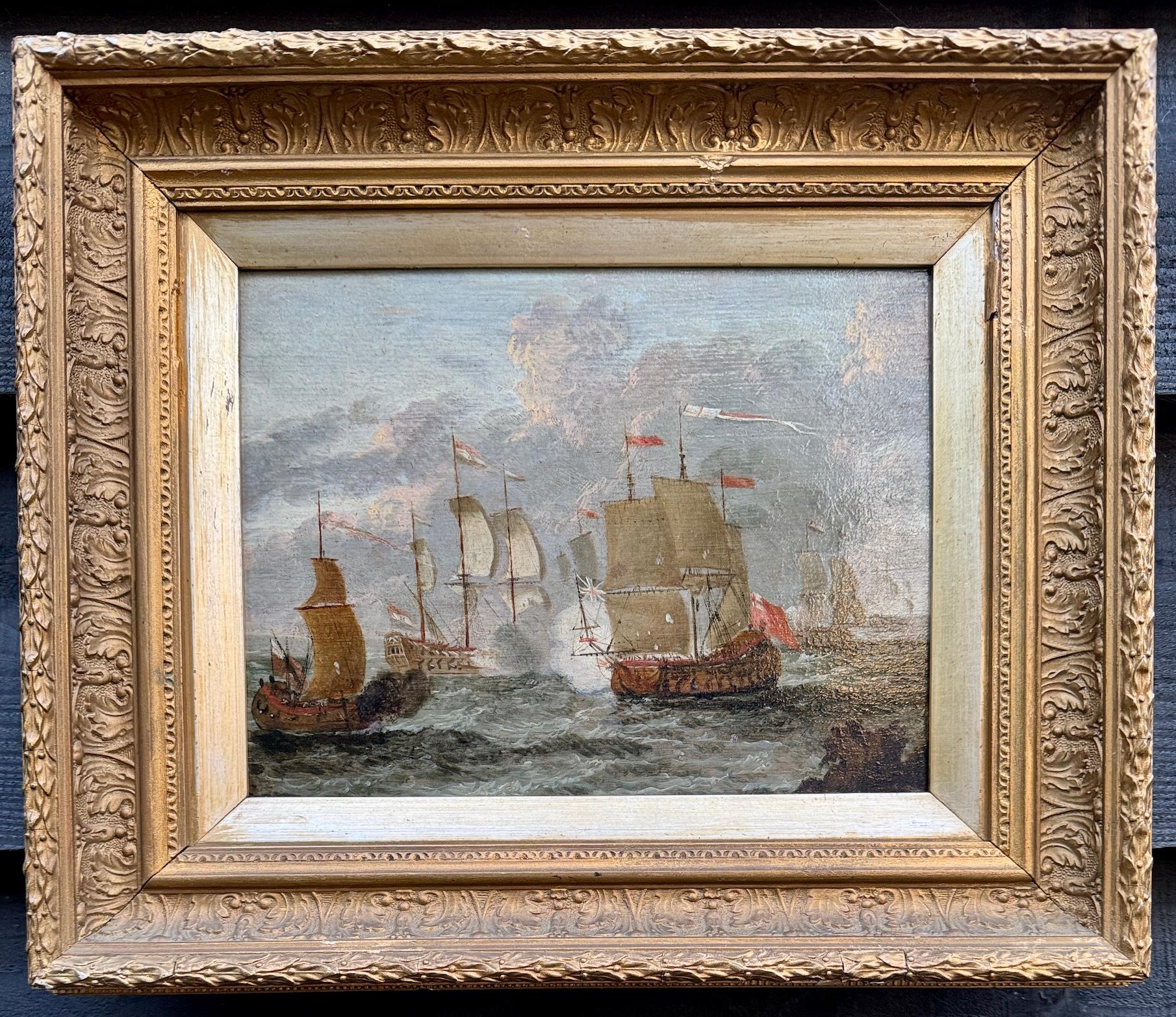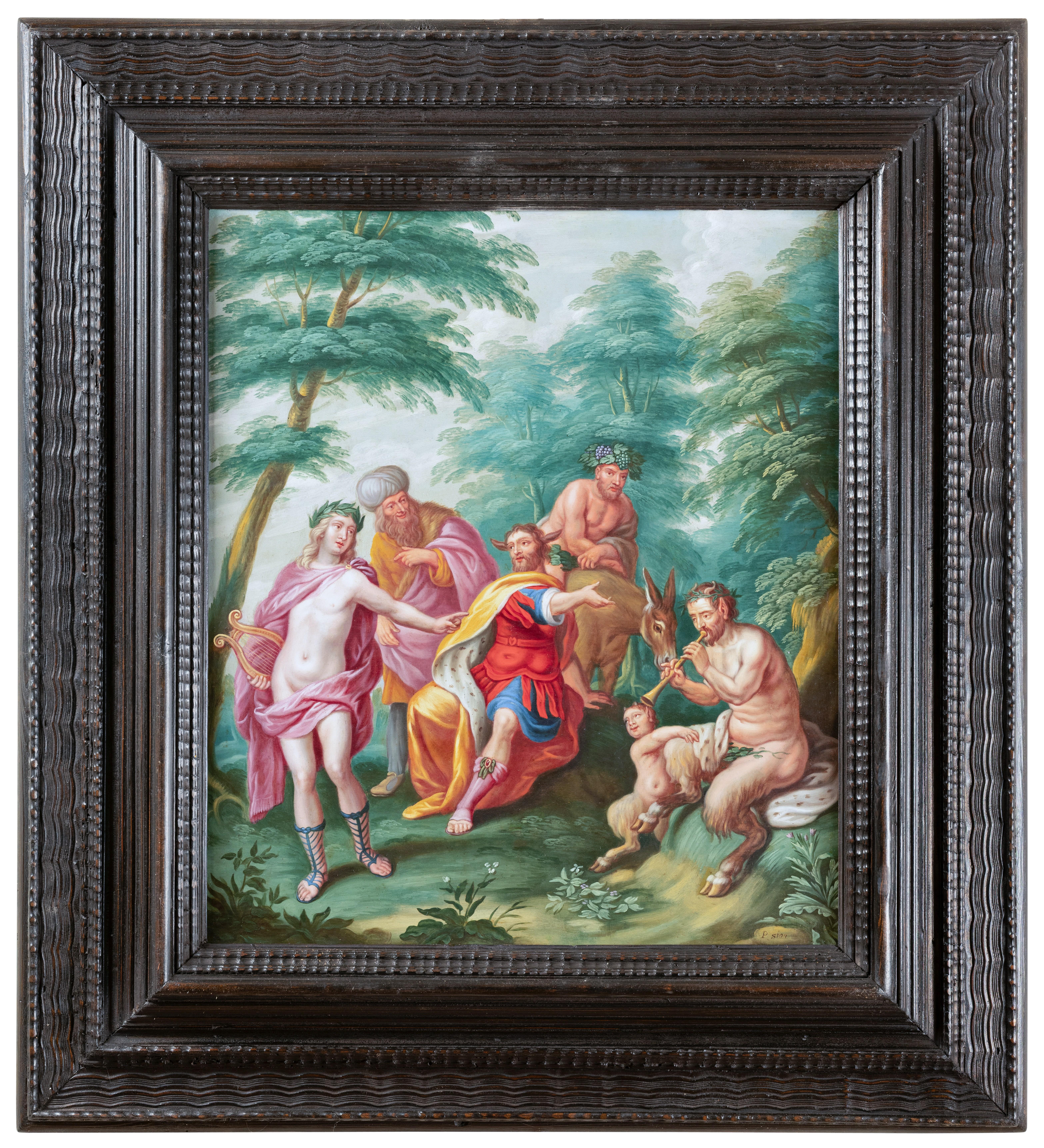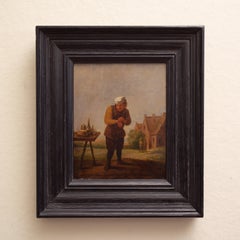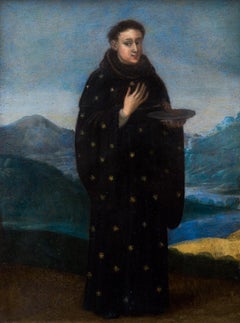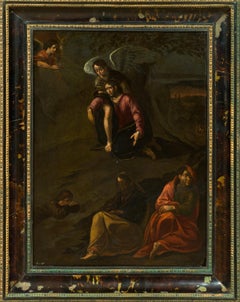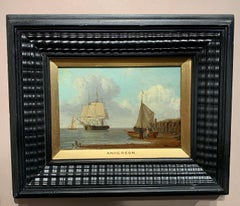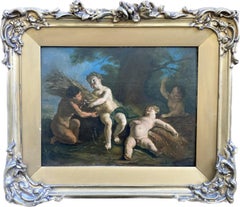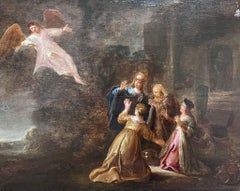Items Similar to The Road to Emmaus, German Old Master Painting
Want more images or videos?
Request additional images or videos from the seller
1 of 10
UnknownThe Road to Emmaus, German Old Master Painting1700s
1700s
About the Item
German School, 1700s
The Road to Emmaus
oil on panel
unframed: 24.3 x 17.5 cm (9.6 x 6.9 inches)
framed: 34.5 x 28 cm (13.6 x 11 inches)
Provenance:
Swedish author and artist Amelie Posse (1884–1957)
Essay:
This 18th-century painting, measuring 24.3 x 17.5 cm, depicts the biblical scene known as "The Road to Emmaus" likely created by an unknown German artist. In this scene, found in Luke 24:13–35 of the New Testament, Jesus appears to two of his disciples after his resurrection, walking alongside them as they journey to the village of Emmaus. The disciples, however, do not recognize him until later, when he breaks bread with them, revealing his true identity.
The painting captures the moment of Jesus' interaction with the disciples, emphasizing the quiet, mystical atmosphere of the encounter. Jesus, draped in a blue mantle, stands in the center, deep in conversation with the disciples. The use of dark tones and soft lighting enhances the spiritual and solemn quality of the moment, inviting viewers to reflect on themes of revelation and faith.
Previously, this artwork was owned by the Swedish author and artist Amelie Posse (1884–1957). Posse, a prominent anti-Nazi activist, was known for founding the resistance organization "Tisdagsklubben" (The Tuesday Club) during World War II, aimed at countering Nazi influence in Sweden. Her life was marked by a commitment to democratic and pacifist ideals, and she played a significant role in assisting refugees from Nazi-occupied Europe.
- Creation Year:1700s
- Dimensions:Height: 13.59 in (34.5 cm)Width: 11.03 in (28 cm)
- Medium:
- Movement & Style:
- Period:
- Condition:Old varnish, recently cleaned. Frame with glass for protection. Ready to hang.
- Gallery Location:Stockholm, SE
- Reference Number:1stDibs: LU1445215387012
About the Seller
5.0
Platinum Seller
Premium sellers with a 4.7+ rating and 24-hour response times
Established in 2020
1stDibs seller since 2020
175 sales on 1stDibs
Typical response time: 1 hour
Associations
International Confederation of Art and Antique Dealers' Associations
- ShippingRetrieving quote...Shipping from: Stockholm, Sweden
- Return Policy
Authenticity Guarantee
In the unlikely event there’s an issue with an item’s authenticity, contact us within 1 year for a full refund. DetailsMoney-Back Guarantee
If your item is not as described, is damaged in transit, or does not arrive, contact us within 7 days for a full refund. Details24-Hour Cancellation
You have a 24-hour grace period in which to reconsider your purchase, with no questions asked.Vetted Professional Sellers
Our world-class sellers must adhere to strict standards for service and quality, maintaining the integrity of our listings.Price-Match Guarantee
If you find that a seller listed the same item for a lower price elsewhere, we’ll match it.Trusted Global Delivery
Our best-in-class carrier network provides specialized shipping options worldwide, including custom delivery.More From This Seller
View AllLandscape with Gentleman on Horseback and Peasant Woman Receiving Alms
By Philips Wouwerman
Located in Stockholm, SE
Workshop / Circle of Philips Wouwerman (1619-1668)
Landscape with Gentleman on Horseback and Peasant Woman Receiving Alms
oil on oak panel
12.40 x 14.17 inches (31.5 x 36 cm)
wit...
Category
17th Century Old Masters Landscape Paintings
Materials
Oak, Oil, Wood Panel
A Peasant Removing a Plaster: The Sense of Touch. By a Follower of David Teniers
By David Teniers the Younger
Located in Stockholm, SE
David Teniers the Younger (1610-1690) Follower of
A Peasant Removing a Plaster: The Sense of Touch
signed T on the table
oil on panel
panel size 7,20 x 5,55 inches (18,3 x 14,4 cm)...
Category
Early 18th Century Old Masters Figurative Paintings
Materials
Panel, Oil
Old Master Painting, Flemish School from 1600s, Saint Nicholas of Tolentino
Located in Stockholm, SE
This small Flemish painting, measuring only 24.5 x 18.5 cm and executed on a copper plate, depicts Saint Nicholas of Tolentino. Created in the 17th century, the artist remains unknow...
Category
17th Century Old Masters Landscape Paintings
Materials
Copper
$3,917 Sale Price
25% Off
Christ Supported by an Angel in the Garden of Gethsemane, On Slate
Located in Stockholm, SE
This evocative Veronese School painting captures the moment in the Garden of Gethsemane when Christ, overwhelmed with sorrow, prays to God before his arrest and crucifixion. Supporte...
Category
Early 17th Century Old Masters Figurative Paintings
Materials
Slate
Abraham and the Sacrifice of His Son Isaac by Adriaen Van Stalbemt, C. 1605-1610
Located in Stockholm, SE
Artist: Adriaen van Stalbemt (Stalbempt) 1580-1662
Title: Abraham and the Sacrifice of His Son Isaac “Das Opfer des Abraham”
According to the Old...
Category
Early 1600s Old Masters Landscape Paintings
Materials
Copper
Peasants in a Cornfield (Boer in het veld) by David Teniers the Younger
By David Teniers the Younger
Located in Stockholm, SE
Remembering the magic of everyday life moments in the art of David Teniers:
The art of David Teniers the Younger (1610–1690) coincided with the heyday of the Flemish Baroque and captured a great variety of motifs of his time. In this painting of a seemingly simple peasant scene lies keys to understanding both the imaginative mind of Teniers as well as why this time period produced some of the most iconic works in all of art history.
As indicated by the name, Teniers was more or less born into his profession. As the son of David Teniers the elder, himself a painter who studied under Rubens, the younger David received training in art from a very young age and had no less than three brothers who also became painters. Because of his father’s frequent financial failures that even at times saw him imprisoned, David the younger helped to rescue the family from ruin through painting copies of old masters. Essentially, the young Teniers was confronted with painting as both a passion and creative expression as well as a necessity during difficult times, an experience that would shape much of his capacity and sensitivity in his coming life.
Despite the hardships, the talent and determination of Teniers was recognized and quickly expanded his possibilities. He had already spent time in France and possibly also England when he was hired by his father’s former teacher Rubens to help with a prestigious commission with mythological paintings, now considered lost, for Philip IV the king Spain. In 1644–54 Teniers was appointed dean of the Antwerp Guild of Saint Luke, manifesting his esteemed position within the artistic community. A few years afterwards he took an important step when relocating to Brussels, where Teniers yet again found new career opportunities that would prove to be very successful.
As the keeper of the collections of Archduke Leopold Wilhelm, a role similar to what we now refer to as an art advisor, Teniers purchased hundreds of important artworks that manifested the prominent status of the Archduke’s collection while at the same time providing an unusual access to inspiration and knowledge for Teniers himself. Since he kept on painting during the same time, his creative scope must have seemed almost bewildering in the great variety of images and stories that he surrounded himself with.
Regardless of how glamorous and culturally stimulating the career of Teniers was, he was as open to the charm and existential importance of everyday life as he was to works of great masters and luxurious collectibles. In his impressive repertoire of genres with everything from exquisite royal portraits, interiors, landscapes and history paintings he always added something new and inventive, highlighting the possibilities of art and importance of an experimental and intuitive mind. It is difficult to single out one aspect or genre to summarize his legacy, since it lies much more in the broad virtuosity across many motifs, although he is particularly remembered for farm scenes and meticulously depicted interiors where other paintings and artworks are captured with an astonishing precision. However, the fact that he is still today one of the most known and celebrated names of the Dutch Golden Age is a proof to the magic of his work, which continues to spark dialogue and wonder in the contemporary viewer of his works.
The farm boy in the field in this painting, which likely dates to the mature part of his career, is a wonderful entry into the mind of Teniers. In the tightly cropped motif, we see him standing right in the middle of the busy harvest when men, women and everyone capable were sent out in the field to collect the crop that formed the very core of their diet and survival. In the background we see a fresh blue sky interspersed with skillfully painted clouds, some trees reaching their autumnal colours and in the far distance the glimpse of a small church and village. The presence of a church in a landscape, so typical of Dutch art, served both a symbolic and visual function as a representation of faith while at the same time defining scale and distance.
In the field, the work is in full action with the farmers spread out in various positions, all in the midst of hard and sweaty labour. While they are portrayed as having nothing else than the work on their mind, our farm boy seems to have his attention directed elsewhere. Standing there with his white, half open shirt, flowy curls and strong, sturdy body; his gaze is directed away, out of the picture and the scythes in his hands. He looks almost smirking, expressed with tremendous subtlety in the slight smile of his lips and big eyes, being just in the middle of losing focus on the work. What is it that steals his attention? What has he seen, or realized, or felt – to break him free of the arduous task of harvesting, if but for a moment?
Here starts the wondering and the questions that are the hallmark of a great piece of art. Instead of explicitly locking in the motif in overly clear symbolism Teniers has chosen an open ended, subtle yet striking moment for us to consider. While it of course can be related to numerous other farm scene depictions of this time, and clever usages of gazes and real-life scenes to underscore various moral or symbolic meanings, the painting can be much more of a contemplation than an explanation or illustration. The ordinary nature and understated yet emotionally textured composition of the motif gives greater space for our own reactions and thoughts. Has he seen a pretty farm girl just passing by? Is he fed up with the farm life, joyously dreaming away for a minute, imagining another future? Or is he simply in need of distraction, looking away and ready for anything that can steal his attention?
One quality that never seem to have escaped Teniers was that of curiosity. During all of his career he constantly investigated, expanded and experimented with not only the style and technique of painting, but with the vision of art itself. Being credited with more or less introducing farm motifs for a broader audience not only tells us of his ability to understand the demand for different motifs, but the sensitivity to transform seemingly ordinary parts of life into deep aesthetic experiences, far beyond their expected reach. The farm boy in this painting is, of course, exactly that. But with the help of one smirk the entire picture is charged with a different energy, awakening many contrasts and relationships between the calm landscape, the hard work and his own breach of effectivity, holding sharp scythes while thinking or seeing something else.
It is no wonder Teniers chose to work with farm scenes as a way of investigating these intricate and delicate plays on expectations and surprises, clarity and ambivalence. It invites us to an appreciation of human everyday life that connects us with the people of 17th century...
Category
Late 17th Century Old Masters Landscape Paintings
Materials
Oil, Canvas
You May Also Like
Antique English 19th century marine scene
By William Anderson
Located in Woodbury, CT
Outstanding English late 18th / early 19th century marine scene by one of Britain's best known and sought after painters.
William (or Wiliam) Anderson (1757 – 27 May 1837) was a Scottish artist specializing in maritime and patriotic themes. He was well-regarded for his detailed and accurate portraits of ships under sail, exhibiting his works annually in London between 1787 and 1811 and then occasionally until 1834. Anderson influenced other artists, notably John Ward and others of the Hull school.
Anderson's early life is obscure, but he is known to have trained as a shipwright before moving to London to become a maritime painter when he was about 30. His training served him well as a painter, providing "a practical nautical knowledge" of his subjects. He earned a reputation for "accuracy and refinement of detail" and was admired for his bright, clear colours. He worked in both oils and watercolours.
He based his style on that of well-known Dutch maritime...
Category
1810s Old Masters Figurative Paintings
Materials
Oil, Wood Panel
$5,962 Sale Price
25% Off
Free Shipping
Old master painting of Cherubs cavorting in a woodland setting
By Jean-Honoré Fragonard
Located in Harkstead, GB
A charming image of cherubs cavorting with sheaths of wheat in a woodland setting.
Follower of Jean-Honoré Fragonard
Cherubs cavorting before a tree
Oil on panel
10¾ x 14 inches exc...
Category
Early 19th Century Old Masters Landscape Paintings
Materials
Oil, Wood Panel
$1,758 Sale Price
21% Off
Fine 17th Century Dutch Old Master Oil on Panel Angelic Visitation to Figures
By Rembrandt van Rijn
Located in Cirencester, Gloucestershire
The Angelic Visitation
Dutch School, mid 17th century
circle of Rembrandt (Dutch 1606-1669)
oil on wooden panel, framed in faux tortoiseshell style frame.
framed: 25 x 28.75
painting...
Category
17th Century Old Masters Figurative Paintings
Materials
Oil, Wood Panel
18th century English marine Battle scene between Dutch and British warships
By Francis Swaine
Located in Woodbury, CT
Attributed to Francis Swaine (British, 1725–1782)
Naval Engagement at Sea, 18th century
Oil on panel
In this evocative seascape, a cluster of ships—flags raised, cannons fired—conve...
Category
1760s Old Masters Landscape Paintings
Materials
Oil, Wood Panel
The Rape of Europa, signed Peter Sion (1624-1695), Antwerp, 17th century
Located in PARIS, FR
The Rape of Europa
By Peter Sion (Antwerp, 1624-1695)
Signed in the lower right corner P. Sion
17th century Antwerp School
Oil on copper, dim. h. 53 cm, w. 45 cm
Moulded and ebonized...
Category
17th Century Old Masters Figurative Paintings
Materials
Oak, Oil, Wood Panel
The Musical Contest between Apollo and Marsyas, signed P. Sion, Antwerp 17th c.
Located in PARIS, FR
The Musical Contest between Apollo and Marsyas,
by Peter Sion (Antwerp, 1624-1695)
Signed in the lower right corner P. Sion
17th century Antwerp School
Oil on copper, dim. h. 53 cm, ...
Category
17th Century Old Masters Figurative Paintings
Materials
Oak, Oil, Wood Panel
Recently Viewed
View AllMore Ways To Browse
Antique Old World Art
1700s Art
Old Testament Paintings
Antique Jesus Painting
Antique Paintings Of Jesus
Antique Village Soft
Bread Painting
Resurrection Paintings
Blue Mantle
Counter Schools
Oil Painting Of Bread
18th Century Oil Painting On Wood Panel
Resurrection Panels
18th Century War Oil Paintings
Swedish Paintings 18th Century
Jesus Resurrection
Jesus With Disciples Painting
Francoise Collandre
